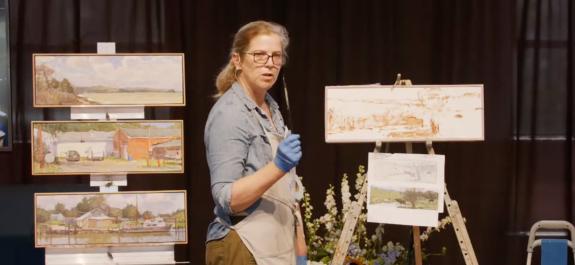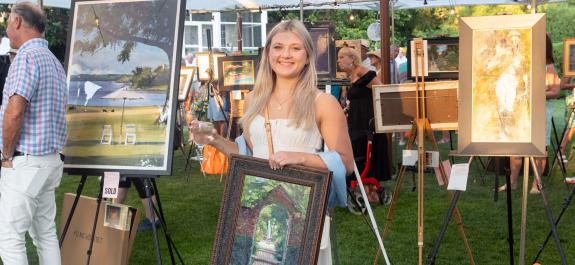An Insight into the Work of Garin Baker by Tim Boyle
As it meanders southward on its journey toward Manhattan and Long Island Sound, the Hudson River passes through some of the most beautifully scenic country in the United States. Lush rolling hills and rocky cliffs line the river and provided welcome inspiration for the earliest Europeans to settle here. Nestled among these hills, along the banks of the Hudson sits the small city of Newburgh, once home to 8,000 troops of the Continental Army as it stood guard over this strategic river during the American Revolution, preventing its use by the British army headquartered in New York City. George Washington gave his famous Newburgh Address nearby during the darkest days of the Revolution, when some of his highest ranking officers threatened mutiny. On this bright, sunny day, one of the troubled streets of Newburgh stands in stark contrast to its noble history and surrounding scenery.
The sidewalk is strewn with litter and lined with a myriad of cracks and crevices giving testament to its toughness and ability to survive despite the obvious long neglect. Behind the sad exteriors of boarded-up doors and broken windows lined with shards of glass, graffiti-laden brick row houses exhibit a stoic grace reminiscent of happier times a century ago. In front of one of the row houses a group of six young men are gathered. Some sitting on the stoop, others standing nearby; all look at home on the street. Baggy white T-shirts coupled with flat-brimmed 5950s set just above the eyes project and image that these are men not to be messed with. Men you would cross the street to avoid. All are doing nothing, or so it seems. Most are staring off into the distance, thinking; no obligations, no place to be, simply taking up time and space. All but one.
One man stands in the sunshine wearing a white tank-top behind flexed biceps and arms folded defensively. His head hangs low with an appearance of bitter resignation. But he is watching. Watching me. With eyes that are cold and hard, eyes that have seen things only he knows about. Eyes that dare me to look back, look him right back in the eyes.
I resist, of course.
But soon I can’t help myself and give in to temptation, look him in the eyes and take in the whole scene. What happens next is unforeseen. The men do nothing but I, that’s right, I spring to action; at least in thought. I reflect on the contrast, the scene, society; what was and is. Old/New. Past/Present. Black/White. Hispanic. America. All this I am taking in from the painting before me.
With his 8’ X 24’ mural ‘Retore’, artist Garin Baker has deftly accomplished what all artists aspire to with their work. He has provoked thought, introspection, reflection, interpretation and discussion. This particular work, an exterior mural done for ‘youths at risk’ can be seen in Newburgh and represents just one of the myriad of styles and themes Baker uses in his American Realism.
Baker jokes that he is ‘cursed’; cursed that he has a creative talent and cursed that as a child he had creative parents. He jokes affectionately, as his appreciation for his childhood and upbringing are readily apparent. His father, an accomplished independent-movie maker, and his mother, a designer, instilled in him early a desire to push boundaries and question the status quo. Baker cut his teeth in the concrete jungle of New York City, a childhood which found his parents at times juggling other jobs so they could pursue their true passions. Their desire for him was not the typical doctor/lawyer/astronaut future but rather one of happiness and personal fulfillment.
Fulfillment he has certainly achieved. Baker was the overall Grand Prize winner at Plein Air Easton in 2013 with his work “A Buck Twenty a Bushel” in addition to First Place finishes at the 2010 Brandywine, De Paint Out and the 2011 Cranford, NJ Paint Out. Beyond the competitions he enters, Baker is also an internationally recognized muralist and fine artist with a client base that spans the globe.
His work “Ship Builders”, a massive 25’ X 30’ exterior mural commissioned by the Ministry of Culture in Helsingor, Denmark, graces the outer, open-faced wall of a four-story building in a historically European, but urban setting. Helsingor, a small coastal city along Denmark’s northeast coast, on the Island of Zealand, has thrived off the water for centuries and is well-represented by the work. It’s depiction of rugged craftsmen, dirty and hard at work in the foreground against the backdrop of the muted steel greys, reds and blacks of a 20th-century shipyard, complements the classic architecture of it’s location beautifully. It not only evokes thought, but also pays homage and appreciation to those who came before us and how important their work still is in the modern, technology-driven world in which we live.
The drive to accurately depict the subjects of his works is one of Baker’s key motivations. “The key for me is to get to the source, the truth”, he says. “The truth for me is to be right in front, to not only capture what is going on, but to FEEL what is going on, the emotion.”
He compiles “tons and tons” of reference material before beginning a work, material which can help provide context, history and also some of the emotion Baker is attempting to convey. Creating an image is difficult enough, using the right color, texture and style in trying to create light shadow and perspective. Creating emotion is something else entirely. In doing so, Baker draws on some of his inspirations; A few of which include John Singer Sargent, Anders Zorn and Joaquin Sorolla. All three achieved international fame during their lifetimes and all three did so partially by pushing the status quo stylistically and thematically; Sargent creating such a scandal with his “A Portrait of Madame X” that he likely left Paris because of it and considered giving up professional painting permanently. The work, however, ultimately helped his career and is now considered, of course, one of the great masterpieces.
He also draws on his own history and experiences to create subjects, themes and emotion. “Maybe because I grew up in the concrete jungle and there were SO many stories happening every single day. Heroic stories.”
Like the lives of many of the boundary pushers before him, Baker admits that the life of an artist, regardless of past or present success, can be bumpy at times. He speaks fondly about the journey which brought him to this point, “I get up every day and I go to work. I’m in the middle of a project and the next day I wake up and I’m broke. It’s not a trajectory. It’s a rolling type of ride. If I can do squeak out a life and do work that I’m passionate about, that’s what it’s all about.”
His passion for his work is very evident, especially in the painting he submitted to Plein Air last year. “A Buck Twenty a Bushel” resonates the very essence of the Chesapeake Bay waterman and life on the Eastern Shore of Maryland. The painting depicts a waterman on his work boat, no shirt, with the straps of his overalls casually slung over his half-burned/half-tanned broad shoulders, staring off into the distance. The emotion it evokes is instantly recognizable to anyone who has worked the waters or seen these heroic figures toiling away at their trade.
The traditional way of life of the Chesapeake Bay waterman continues to disappear as the small fisherman is squeezed out by commercial fleets, encroaching development and oppressive government regulation. The ever increasing presence of tourists and recreational boaters, negatively impacting the environment in and around his workplace, adds to the burden. The waterman takes all this in, not necessarily in stride, but he takes it in none the less, worries, balances his unique bond with the Chesapeake and its teeming life, goes about his business and tries to eek out any living the bay will allow. He loves it, after all.
There is a passion and mystique within every waterman and Baker captured it perfectly. The intuitive effort paid off at last year’s Plein Air, winning the Grand Prize. Baker expresses a humble gratitude for the recognition he received. But more importantly, he is appreciative of what Plein Air Easton does for art and artists everywhere. The Plein Air festival is unique in that it is a GREAT community and a GREAT audience which supports the Plein Air artists”, he says. “The kernel of genius they promote is that they raise the art and the artists to pedestal level. They truly appreciate it.” When speaking of what makes Plein Air Easton the premier event in the United States, Baker waxes nostalgically about other events he’s seen throughout his career where the same attention to detail may have been lacking; of art being viewed in dingy environs, or in one particular case where the art was hung outdoors on chain-link fences. “In Easton there’s a lot of razzmatazz, a lot of celebrating the art and the artists. There’s a lot of respect.”
Garin will be back for Plein Air 2014 and he can’t wait to see you there in July. Who knows, you just may be his next inspiration.


 MY ACCOUNT
MY ACCOUNT CART
CART DONATE
DONATE JOIN THE LIST
JOIN THE LIST




